Broadening the Perspective of Zero-Deforestation Interventions in Peru by Incorporating Concepts from the Global Value Chain Literature
Abstract
1. Introduction
2. Materials and Methods
2.1. The Case Study
2.2. Cacao, Coffee, and Oil Palm Production in Peru
2.3. Spatial Associations
3. Results
3.1. Correlations between Deforestation and the Area Cultivated with Cacao, Coffee, and Oil Palm in Peru
3.2. Spatial Associations between Deforestation and Areas Cultivated with Cacao, Coffee, and Oil Palm
3.3. Scenarios under Which ZDSC Initiatives May Operate in Peru
4. Discussion
4.1. Spatial Associations between Deforestation and Cacao, Coffee, and Oil Palm Production
4.2. Scenarios Where ZDSC Initiatives May Operate in Peru
4.3. Additional Factors That ZDSC Interventions Need to Consider
4.4. Incorporating Concepts from the GVC Literature
4.5. Limitations of the Methodology
5. Conclusions
Author Contributions
Funding
Institutional Review Board Statement
Informed Consent Statement
Conflicts of Interest
References
- Pendrill, F.; Persson, U.M.; Godar, J.; Kastner, T. Deforestation Displaced: Trade in Forest-Risk Commodities and the Prospects for a Global Forest Transition. Environ. Res. Lett. 2019, 14, 055003. [Google Scholar] [CrossRef]
- IPCC. Climate Change and Land: An IPCC Special Report on Climate Change, Desertification, Land Degradation, Sustainable Land Management, Food Security, and Greenhouse Gas Fluxes in Terrestrial Ecosystems; Shukla, P.R., Skea, J., Calvo Buendía, E., Masson-Delmotte, V., Pörtner, H.-O., Roberts, D., Zhai, P., Slade, R., Connors, S., van Diemen, R., et al., Eds.; IPCC: Geneva, Switzerland, 2019. [Google Scholar]
- UNFCCC. Conference of Parties Report of the Conference of the Parties on Its Thirteenth Session, Held in Bali from 3 to 15 December 2007 Part One: Proceedings; UNFCCC: Bali, Indonesia, 2008. [Google Scholar]
- UNFCCC. Report of the Conference of the Parties on Its Nineteenth Session, Held in Warsaw from 11 to 23 November 2013. Addendum. Part Two: Action Taken by the Conference of the Parties at Its Nineteenth Session; UNFCCC: Warsaw, Poland, 2014. [Google Scholar]
- Lambin, E.F.; Gibbs, H.K.; Heilmayr, R.; Carlson, K.M.; Fleck, L.C.; Garrett, R.D.; le Polain de Waroux, Y.; McDermott, C.L.; McLaughlin, D.; Newton, P.; et al. The Role of Supply-Chain Initiatives in Reducing Deforestation. Nat. Clim. Chang. 2018, 8, 109–116. [Google Scholar] [CrossRef]
- Umunay, P.; Lujan, B.; Meyer, C.; Cobián, J. Trifecta of Success for Reducing Commodity-Driven Deforestation: Assessing the Intersection of REDD+ Programs, Jurisdictional Approaches, and Private Sector Commitments. Forests 2018, 9, 609. [Google Scholar] [CrossRef]
- Neeff, T.; Linhares-Juvenal, T. Zero-Deforestation Commitments A New Avenue towards Enhanced Forest Governance? FAO: Rome, Italy, 2018. [Google Scholar]
- Sunderlin, W.D.; Ekaputri, A.D.; Sills, E.O.; Duchelle, A.E.; Kweka, D.; Diprose, R.; Doggart, N.; Ball, S.; Lima, R.; Enright, A.; et al. The Challenge of Establishing REDD+ on the Ground Insights from 23 Subnational Initiatives in Six Countries; Center for International Forestry Research: Bogor, Indonesia, 2014. [Google Scholar]
- Donofrio, S.; Rothrock, P.; Leonard, J. Supply Change: Tracking Corporate Commitments to Deforestation-Free Supply Chains, 2017; Forest Trends Association: Washington, DC, USA, 2017. [Google Scholar]
- Assuncąo, J.; Gandour, C.; Rocha, R. Deforestation Slowdown in the Brazilian Amazon: Prices or Policies? Environ. Dev. Econ. 2015, 20, 697–722. [Google Scholar] [CrossRef]
- Alix-Garcia, J.; Gibbs, H.K. Forest Conservation Effects of Brazil’s Zero Deforestation Cattle Agreements Undermined by Leakage. Glob. Environ. Chang. 2017, 47, 201–217. [Google Scholar] [CrossRef]
- Bastos Lima, M.G.; Persson, U.M. Commodity-Centric Landscape Governance as a Double-Edged Sword: The Case of Soy and the Cerrado Working Group in Brazil. Front. For. Glob. Chang. 2020, 3, 27. [Google Scholar] [CrossRef]
- Essen, M.; Lambin, E.F. Jurisdictional Approaches to Sustainable Resource Use. Front. Ecol. Environ. 2021, 19, fee.2299. [Google Scholar] [CrossRef]
- Tropenbos International. Zero Deforestation: A Commitment to Change; Pasiecznik, N., Savenije, H., Eds.; Tropenbos International: Wageningen, The Netherlands, 2017; ISBN 978-90-5113-134-5. [Google Scholar]
- Garrett, R.D.; Levy, S.; Carlson, K.M.; Gardner, T.A.; Godar, J.; Clapp, J.; Dauvergne, P.; Heilmayr, R.; le Polain de Waroux, Y.; Ayre, B.; et al. Criteria for Effective Zero-Deforestation Commitments. Glob. Environ. Chang. 2019, 54, 135–147. [Google Scholar] [CrossRef]
- Heilmayr, R.; Carlson, K.M.; Benedict, J.J. Deforestation Spillovers from Oil Palm Sustainability Certification. Environ. Res. Lett. 2020, 15, 075002. [Google Scholar] [CrossRef]
- Meyfroidt, P.; Börner, J.; Garrett, R.; Gardner, T.; Godar, J.; Kis-Katos, K.; Soares-Filho, B.S.; Wunder, S.; Meyfroidt, P. Focus on Leakage and Spillovers: Informing Land-Use Governance in a Tele-Coupled World. Environ. Res. Lett. 2020, 15, 090202. [Google Scholar] [CrossRef]
- Food and Agriculture Organization. Global Forest Resource Assessment 2020; FAO: Rome, Italy, 2020. [Google Scholar]
- Newton, P.; Agrawal, A.; Wollenberg, L. Enhancing the Sustainability of Commodity Supply Chains in Tropical Forest and Agricultural Landscapes. Glob. Environ. Chang. 2013, 23, 1761–1772. [Google Scholar] [CrossRef]
- Blackman, A.; Rivera, J. Producer-Level Benefits of Sustainability Certification. Conserv. Biol. 2011, 25, 1176–1185. [Google Scholar] [CrossRef] [PubMed]
- European Commission EU Communication (2019) on Stepping up EU Action to Protect and Restore the World’s Forests. Available online: https://ec.europa.eu/environment/forests/eu_comm_2019.htm (accessed on 1 October 2021).
- Castro-Nunez, A.; Charry, A.; Castro-Llanos, F.; Sylvester, J.; Bax, V. Reducing Deforestation through Value Chain Interventions in Countries Emerging from Conflict: The Case of the Colombian Cocoa Sector. Appl. Geogr. 2020, 123, 102280. [Google Scholar] [CrossRef]
- de Marchi, V.; di Maria, E.; Krishnan, A.; Ponte, S. Environmental upgrading in global value chains. In Handbook on Global Value Chains; Ponte, S., Gary, G., Raj-Reichert, G., Eds.; Edward Elgar Publishing: Cheltenham, UK, 2019; pp. 310–323. ISBN 9781788113762. [Google Scholar]
- Mentzer, J.T.; DeWitt, W.; Keebler, J.S.; Min, S.; Nix, N.W.; Smith, C.D.; Zacharia, Z.G. Defining Supply Chain Management. J. Bus. Logist. 2001, 22, 1–25. [Google Scholar] [CrossRef]
- Gereffi, G.; Lee, J. Economic and Social Upgrading in Global Value Chains and Industrial Clusters: Why Governance Matters. J. Bus. Ethics 2016, 133, 25–38. [Google Scholar] [CrossRef]
- Lambin, E.F.; Gibbs, H.K.; Ferreira, L.; Grau, R.; Mayaux, P.; Meyfroidt, P.; Morton, D.C.; Rudel, T.K.; Gasparri, I.; Munger, J. Estimating the World’s Potentially Available Cropland Using a Bottom-up Approach. Glob. Environ. Chang. 2013, 23, 892–901. [Google Scholar] [CrossRef]
- Cabieses, H. The “miracle of San Martín” and Symptoms of “Alternative Development” in Peru Conclusions & Recommendations. Available online: https://www.tni.org/en/briefing/miracle-san-martin-and-symptoms-alternative-development-peru (accessed on 25 October 2021).
- Bennett, A.; Ravikumar, A.; Cronkleton, P. The Effects of Rural Development Policy on Land Rights Distribution and Land Use Scenarios: The Case of Oil Palm in the Peruvian Amazon. Land Use Policy 2018, 70, 84–93. [Google Scholar] [CrossRef]
- Meyer, C.; Miller, D. Zero Deforestation Zones: The Case for Linking Deforestation-Free Supply Chain Initiatives and Jurisdictional REDD+. J. Sustain. For. 2015, 34, 559–580. [Google Scholar] [CrossRef]
- Seymour, F.; Harris, N.L. Reducing Tropical Deforestation. Science 2019, 365, 756–757. [Google Scholar] [CrossRef] [PubMed]
- Leijten, F.; Sim, S.; King, H.; Verburg, P.H. Which Forests Could Be Protected by Corporate Zero Deforestation Commitments? A Spatial Assessment. Environ. Res. Lett. 2020, 15, 064021. [Google Scholar] [CrossRef]
- Ferrer Velasco, R.; Köthke, M.; Lippe, M.; Günter, S. Scale and Context Dependency of Deforestation Drivers: Insights from Spatial Econometrics in the Tropics. PLoS ONE 2020, 15, e0226830. [Google Scholar] [CrossRef] [PubMed]
- Global Forest Watch Peru Deforestation Rates & Statistics. Available online: https://www.globalforestwatch.org/dashboards/country/PER/ (accessed on 26 October 2020).
- Government of Peru Estrategia Nacional Sobre Bosques y Cambio Climático 2016. Available online: http://www.bosques.gob.pe/archivo/ff3f54_ESTRATEGIACAMBIOCLIMATICO2016_ok.pdf (accessed on 31 July 2021).
- Governments of Peru Germany and Norway Joint Declaration of Intent between the Government of the Republic of Peru, the Government of the Kingdom of Norway and the Government of the Federal Republic of Germany on “Cooperation on Reducing Greenhouse Gas Emissions from Deforestation and Forest De 2014. Available online: https://www.regjeringen.no/contentassets/b324ccc0cf88419fab88f2f4c7101f20/declarationofintentperu.pdf (accessed on 31 July 2021).
- Pendrill, F.; Persson, U.M.; Kastner, T. Deforestation Risk Embodied in Production and Consumption of Agricultural and Forestry Commodities 2005–2017. Available online: https://zenodo.org/record/4250532#.YXbAB44zZPY (accessed on 31 July 2021).
- Ravikumar, A.; Sears, R.R.; Cronkleton, P.; Menton, M.; Pérez-Ojeda del Arco, M. Is Small-Scale Agriculture Really the Main Driver of Deforestation in the Peruvian Amazon? Moving beyond the Prevailing Narrative. Conserv. Lett. 2017, 10, 170–177. [Google Scholar] [CrossRef]
- Ministerio del Ambiente (MINAM) Geobosques 2018. Available online: http://www.bosques.gob.pe/notasdeprensa/geobosques-del-minam-gano-premio-conectarse-para-crecer-2018-en-la-categoria-estado-nacional (accessed on 31 July 2021).
- Ministerio de Agricultura y Riego (MINAGRI) District Level Data on Cacao, Coffee, Palm Oil and Cattle Production in Peru (Unpublished Dataset) 2018.
- Instituto Nacional de Estadística e Informática (INEI) Encuesta Nacional Agropecuaria 2016. Available online: https://www.inei.gob.pe/media/MenuRecursivo/boletines/exposicion_ena2016.pdf (accessed on 31 July 2021).
- Anselin, L. Local Indicators of Spatial Association—LISA. Geogr. Anal. 1995, 27, 93–115. [Google Scholar] [CrossRef]
- Brown, S.; Zarin, D. What Does Zero Deforestation Mean? Science 2013, 342, 805–807. [Google Scholar] [CrossRef]
- Lyons-White, J.; Pollard, E.H.B.; Catalano, A.S.; Knight, A.T. Rethinking Zero Deforestation beyond 2020 to More Equitably and Effectively Conserve Tropical Forests. One Earth 2020, 3, 714–726. [Google Scholar] [CrossRef]
- Deans, H.; Ros-Tonen, M.A.F.; Derkyi, M. Advanced Value Chain Collaboration in Ghana’s Cocoa Sector: An Entry Point for Integrated Landscape Approaches? Environ. Manag. 2018, 62, 143–156. [Google Scholar] [CrossRef]
- Furumo, P.R.; Lambin, E.F. Scaling up Zero-Deforestation Initiatives through Public-Private Partnerships: A Look inside Post-Conflict Colombia. Glob. Environ. Chang. 2020, 62, 102055. [Google Scholar] [CrossRef]
- Carlson, K.M.; Heilmayr, R.; Gibbs, H.K.; Noojipady, P.; Burns, D.N.; Morton, D.C.; Walker, N.F.; Paoli, G.D.; Kremen, C. Effect of Oil Palm Sustainability Certification on Deforestation and Fire in Indonesia. Proc. Natl. Acad. Sci. USA 2018, 115, 121–126. [Google Scholar] [CrossRef] [PubMed]
- Ponte, S. Green Capital Accumulation: Business and Sustainability Management in a World of Global Value Chains. New Political Econ. 2020, 25, 72–84. [Google Scholar] [CrossRef]
- Navarrete, S.D.S.; Borini, F.M.; Avrichir, I. Environmental Upgrading and the United Nations Sustainable Development Goals. J. Clean. Prod. 2020, 264, 121563. [Google Scholar] [CrossRef]
- Instituto de Defensa Legal Ministry of Agriculture Denies Environmental Certification to Palm Grower Ocho Sur P. Available online: https://www.idl.org.pe/ministerio-de-agricultura-deniega-certificacion-ambiental-a-la-palmicultora-ocho-sur-p/ (accessed on 8 April 2021).
- Kaplinsky, R.; Morris, M. How Regulation and Standards Can Support Social and Environmental Dynamics in Global Value Chains. Available online: https://www.greengrowthknowledge.org/sites/default/files/downloads/resource/How%20Regulation%20and%20Standards%20Can%20Support%20Social%20and%20Environmental%20Dynamics%20in%20Global%20Value%20Chains.pdf. (accessed on 31 July 2021).
- Lambin, E.F.; Meyfroidt, P.; Rueda, X.; Blackman, A.; Börner, J.; Cerutti, P.O.; Dietsch, T.; Jungmann, L.; Lamarque, P.; Lister, J.; et al. Effectiveness and Synergies of Policy Instruments for Land Use Governance in Tropical Regions. Glob. Environ. Chang. 2014, 28, 129–140. [Google Scholar] [CrossRef]
- Pacheco, P.; Schoneveld, G.; Dermawan, A.; Komarudin, H.; Djama, M. Governing Sustainable Palm Oil Supply: Disconnects, Complementarities, and Antagonisms between State Regulations and Private Standards. Regul. Gov. 2018, 14, 568–598. [Google Scholar] [CrossRef]
- Vijay, V.; Reid, C.D.; Finer, M.; Jenkins, C.N.; Pimm, S.L. Deforestation Risks Posed by Oil Palm Expansion in the Peruvian Amazon. Environ. Res. Lett. 2018, 13, 114010. [Google Scholar] [CrossRef]
- Monitoring of the Andean Amazon Project MAAP # 134: Agriculture and Deforestation in the Peruvian Amazon | MAAP. Available online: https://maaproject.org/2021/deforestacion-agricultura-peru/ (accessed on 5 April 2021).
- Rudel, T.K.; Horowitz, B. Tropical Deforestation: Small Farmers and Land Clearing in the Ecuadorian Amazon; Columbia University Press: New York, NY, USA, 1993. [Google Scholar]
- Castro-Nunez, A.; Mertz, O.; Sosa, C.C. Geographic Overlaps between Priority Areas for Forest Carbon-Storage Efforts and Those for Delivering Peacebuilding Programs: Implications for Policy Design. Environ. Res. Lett. 2017, 12, 054014. [Google Scholar] [CrossRef]
- Castro-Nunez, A.; Mertz, O.; Buritica, A.; Sosa, C.C.; Lee, S.T. Land Related Grievances Shape Tropical Forest-Cover in Areas Affected by Armed-Conflict. Appl. Geogr. 2017, 85, 39–50. [Google Scholar] [CrossRef]
- Raschio, G.; Smetana, S.; Contreras, C.; Mathys, A.; Heinz, V. Spatiotemporal Tools for Regional Low-Carbon Development: Linking LCA and GIS to Assess Clusters of GHG Emissions from Cocoa Farming in Peru. In Sustainability Through Innovation in Product Life Cycle Design; Springer: Singapore, 2017; pp. 969–980. [Google Scholar]
- Jezeer, R.; Verweij, P. Shade Grown Coffee-Double Dividend for Biodiversity and Small-Scale Coffee Farmers in Peru; Hivos: Hague, The Netherlands, 2015. [Google Scholar]
- Palomino, E.R.; Hilario Meza, S.; Robles Montes, D.; Sotelo Raffo, F.; Wei-Shuo, L. Organic Coffee Supply Chain Management in the San Martin Region of Peru. Int. J. Innov. Manag. Technol. 2017, 8, 9–16. [Google Scholar] [CrossRef][Green Version]
- Gutiérrez-Vélez, V.H.; DeFries, R.; Pinedo-Vásquez, M.; Uriarte, M.; Padoch, C.; Baethgen, W.; Fernandes, K.; Lim, Y. High-Yield Oil Palm Expansion Spares Land at the Expense of Forests in the Peruvian Amazon. Environ. Res. Lett. 2011, 6, 044029. [Google Scholar] [CrossRef]
- Charry, A.; Vélez, A.F.; Romero, M.; Ivanova, Y.; Tristán, M.C.; Lema, S.; Sánchez Choy, J.; Orjuela, F.; Jäger, M. Comprehensive Strategy to Strengthen the Competitiveness Plan of the Oil Palm Chain in Ucayali; Centro Internacional de Agricultura Tropical (CIAT): Palmira, Colombia, 2020. [Google Scholar]
- Ivanova, Y.; Tristán, M.C.; Romero, M.; Charry, A.; Lema, S.; Sánchez Choy, J.; Vélez, A.; Castro, A.; Quintero, M. Moving towards a Deforestation-Free Cacao and Chocolate Value Chain with Low Greenhouse Gas Emissions Current Status, Opportunities and an Action Plan for the Ucayali Region; Centro Internacional de Agricultura Tropical (CIAT): Palmira, Colombia, 2020. [Google Scholar]
- Earth Innovation Institute Peru-Based Coalition Releases Roadmap on Sustainability and Forest Protection-Earth Innovation Institute. Available online: https://earthinnovation.org/2020/07/peru-based-coalition-releases-roadmap-on-sustainability-and-forest-protection/ (accessed on 8 April 2021).
- Gereffi, G.; Fernandez-Stark, K. Global Value Chain Analysis: A Primer, 2nd ed.; Duke GVC Center: Durham, NC, USA, 2016. [Google Scholar]
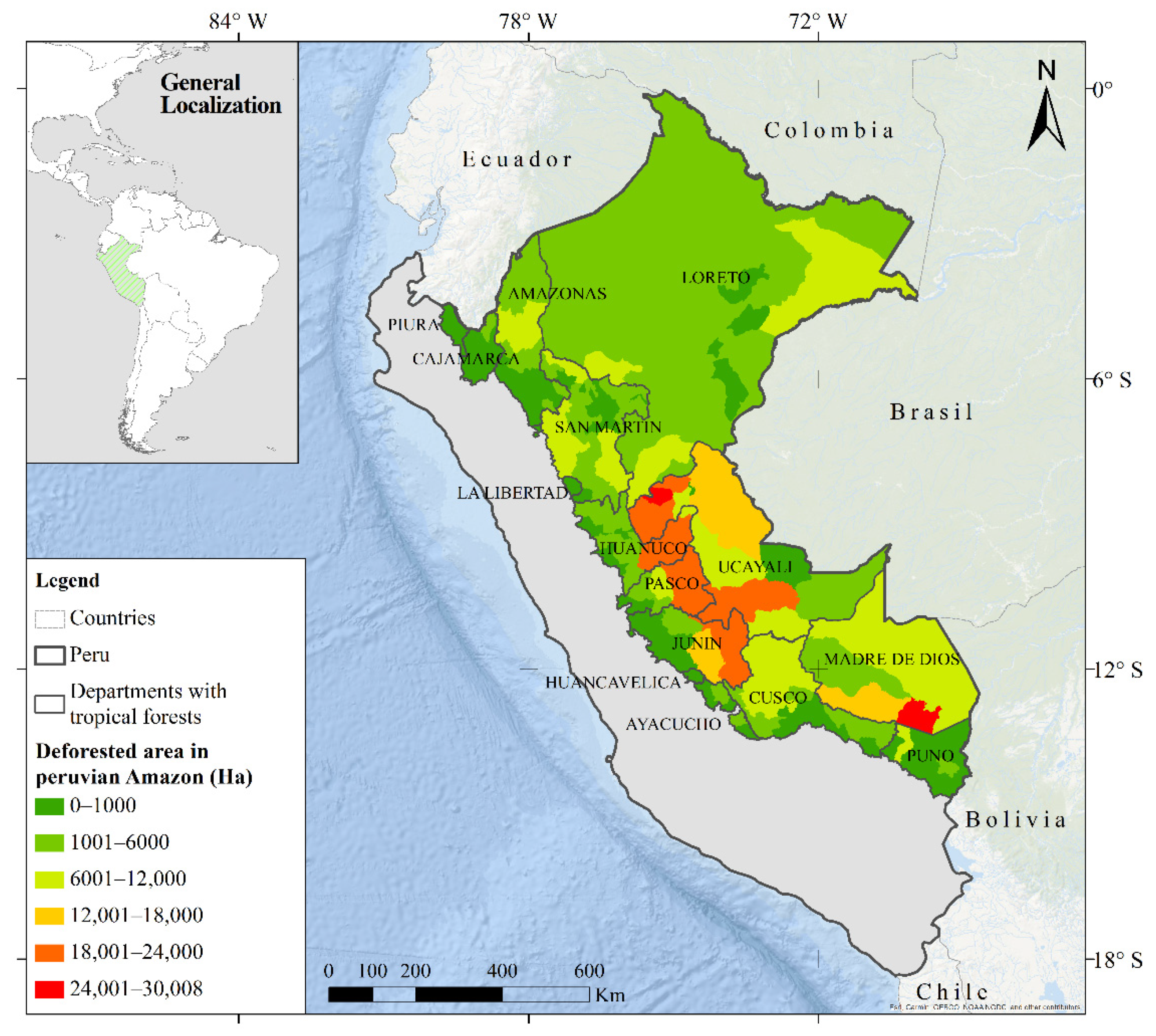
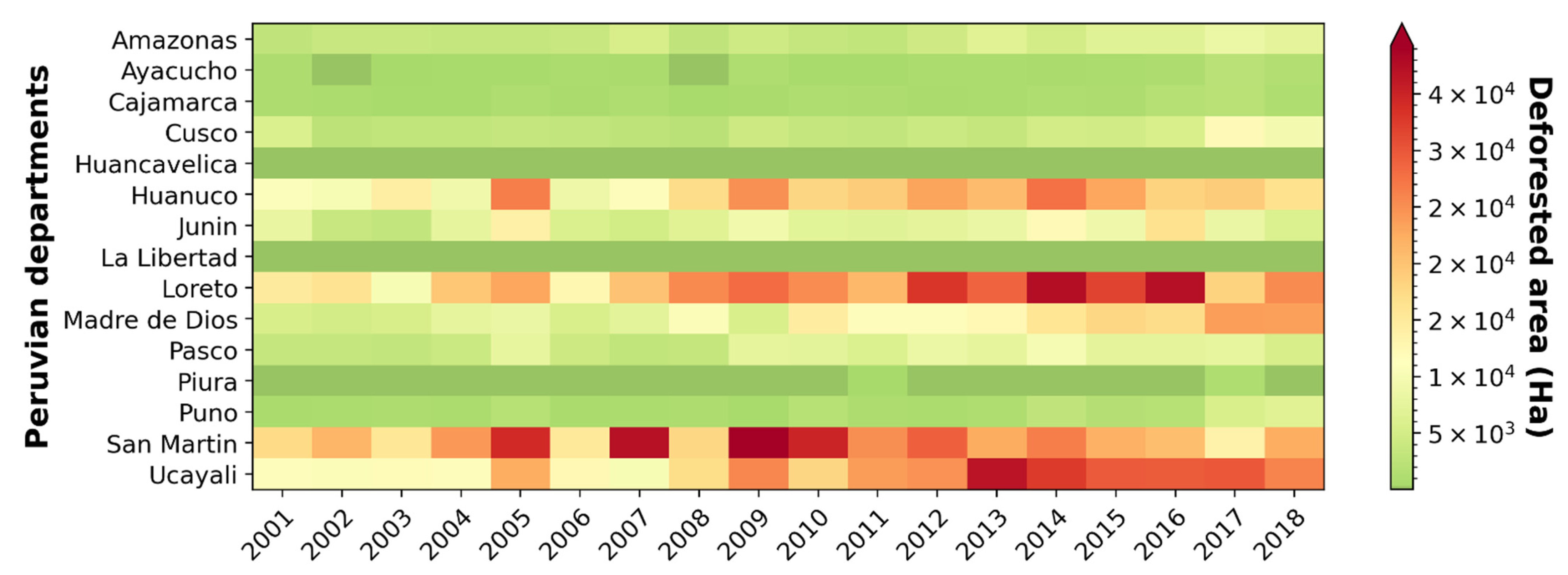
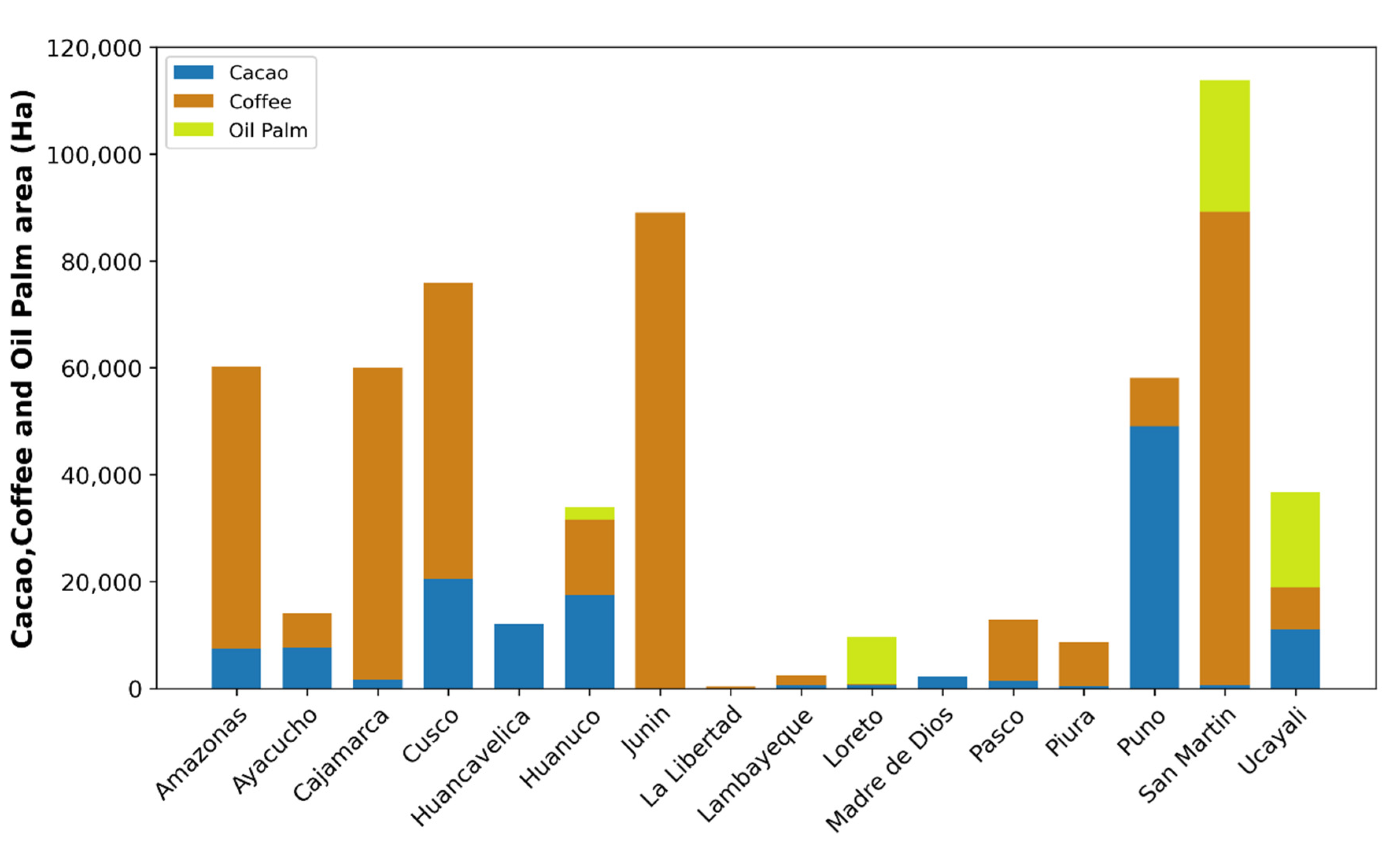
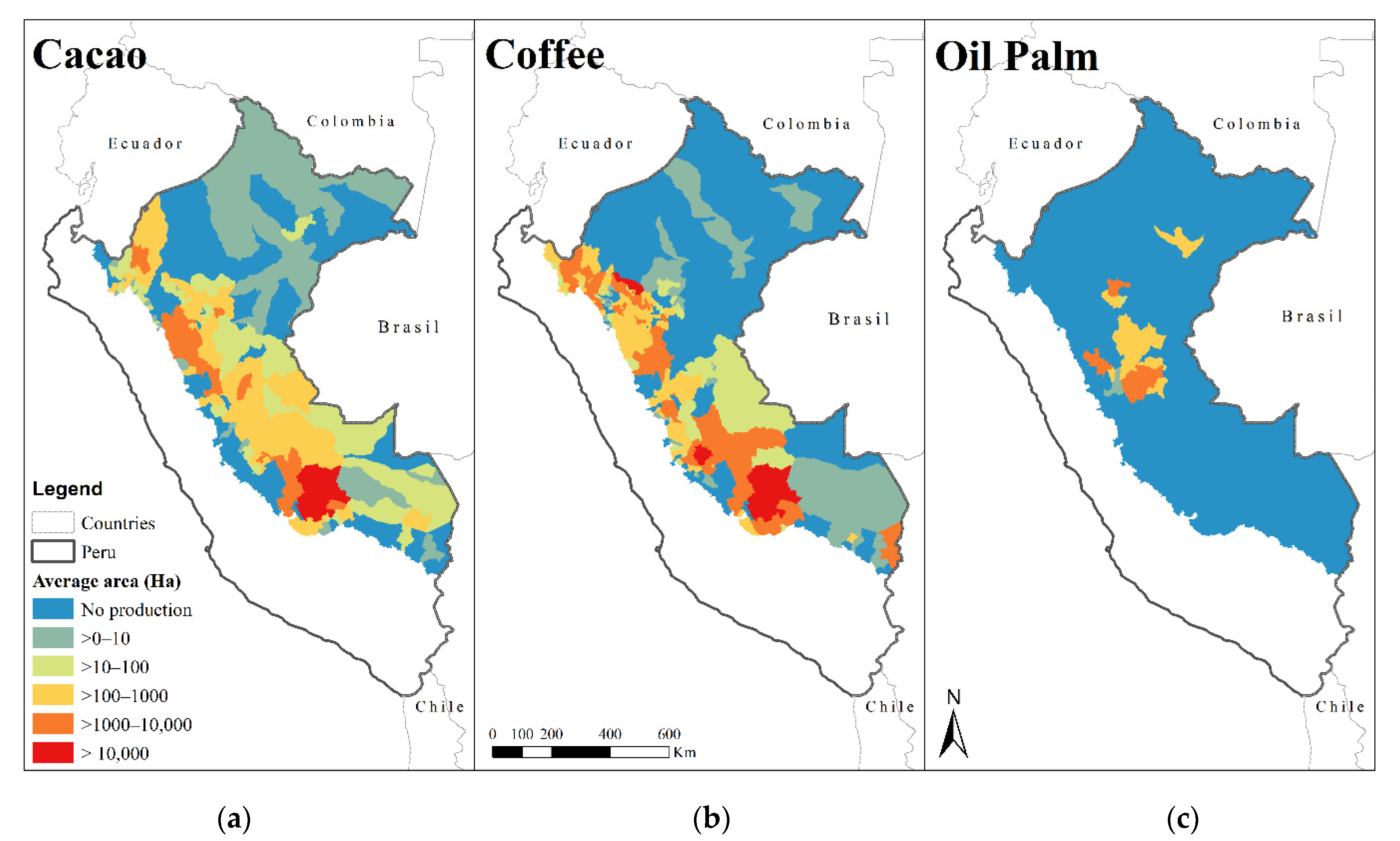
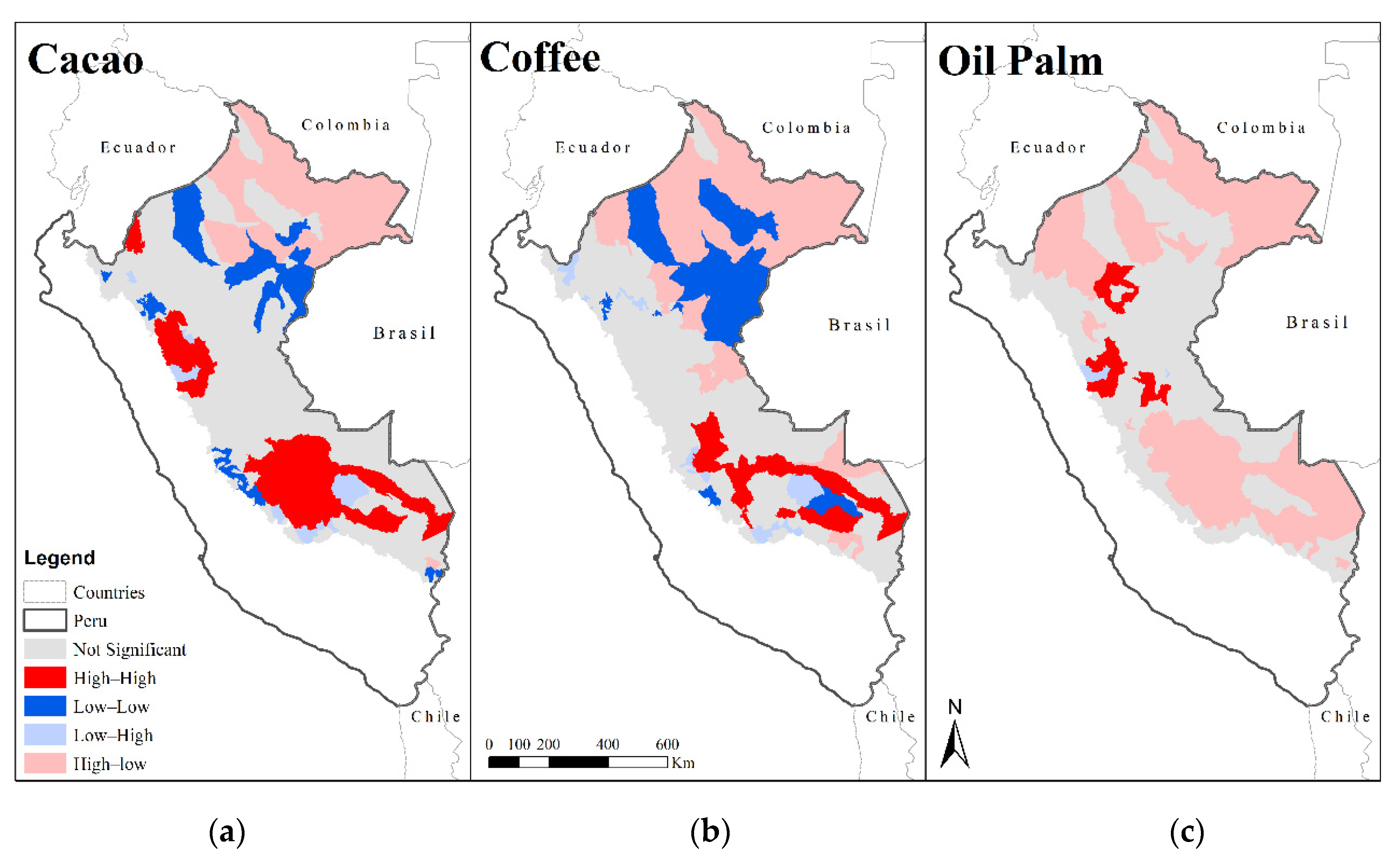
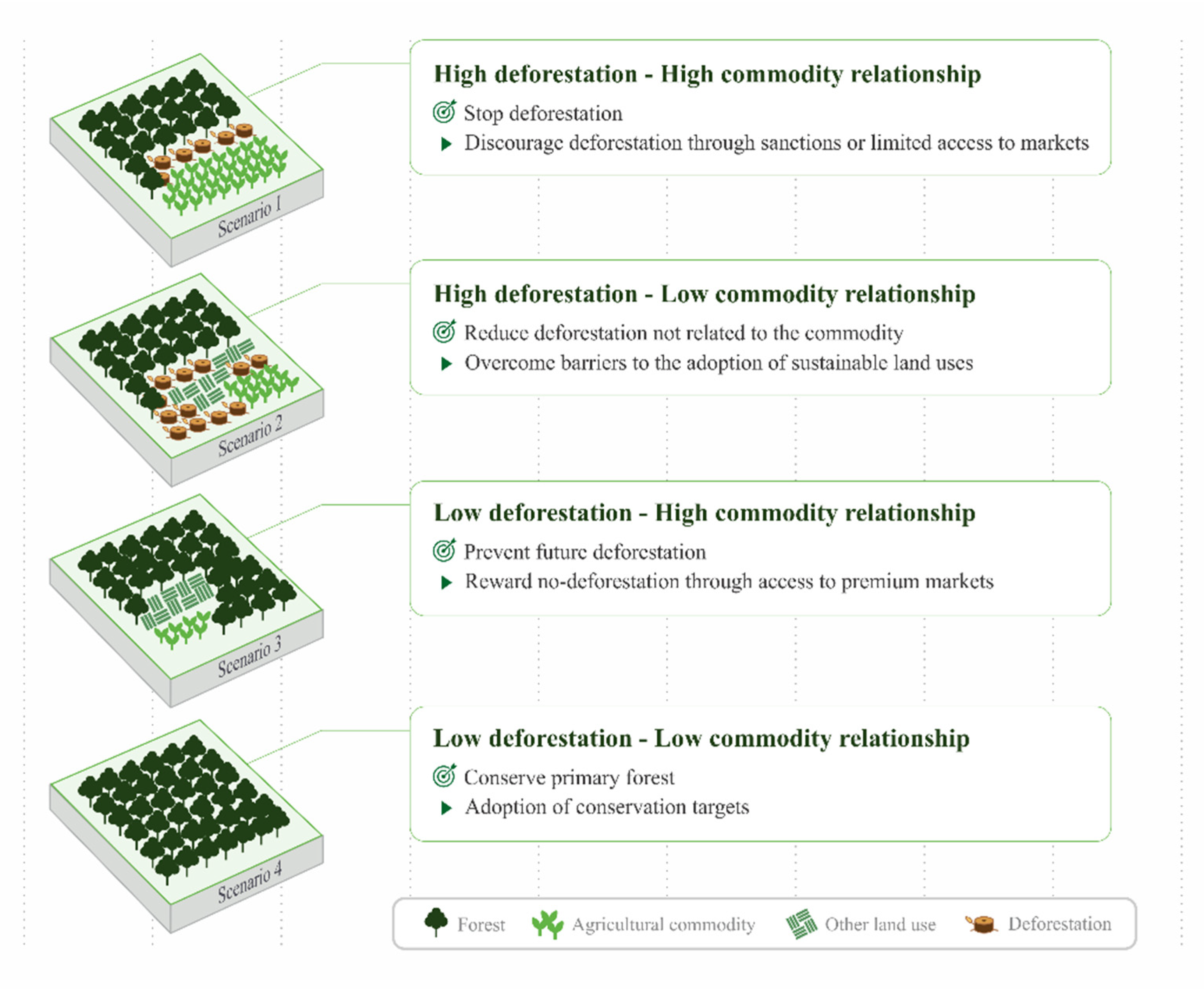
| Department | Districts (#) | Cacao | Coffee | Oil Palm |
|---|---|---|---|---|
| Amazonas | 83 | 0.39 | 0.55 | NA |
| Ayacucho | 7 | not sig. | 0.88 | NA |
| Cajamarca | 19 | not sig. | 0.68 | NA |
| Cusco | 18 | 0.48 | not sig. | NA |
| Huancavelica | 4 | NA | NA | Na |
| Huanuco | 25 | 0.55 | not sig. | not sig. |
| Junin | 27 | 0.6 | 0.72 | NA |
| La Libertad | 3 | NA | NA | NA |
| Loreto | 47 | not sig. | not sig. | 0.35 |
| Madre De Dios | 10 | 0.66 | not sig. | NA |
| Pasco | 10 | 0.75 | not sig. | NA |
| Piura | 5 | NA | not sig. | NA |
| Puno | 16 | 0.65 | 0.74 | NA |
| San Martin | 77 | 0.61 | 0.48 | 0.38 |
| Ucayali | 14 | 0.72 | 0.76 | not sig. |
| Amazon Region ρ | 365 | 0.46 | 0.18 | 0.31 |
| Association | Cacao | Coffee | Oil Palm |
|---|---|---|---|
| High deforestation-high crop production | 22 | 10 | 15 |
| High deforestation-low crop production | 14 | 29 | 49 |
| Low deforestation-high crop production | 17 | 30 | 5 |
| Low deforestation-low crop production | 69 | 44 | - |
| Not significant | 243 | 252 | 296 |
Publisher’s Note: MDPI stays neutral with regard to jurisdictional claims in published maps and institutional affiliations. |
© 2021 by the authors. Licensee MDPI, Basel, Switzerland. This article is an open access article distributed under the terms and conditions of the Creative Commons Attribution (CC BY) license (https://creativecommons.org/licenses/by/4.0/).
Share and Cite
Castro-Nunez, A.C.; Villarino, M.E.J.; Bax, V.; Ganzenmüller, R.; Francesconi, W. Broadening the Perspective of Zero-Deforestation Interventions in Peru by Incorporating Concepts from the Global Value Chain Literature. Sustainability 2021, 13, 12138. https://doi.org/10.3390/su132112138
Castro-Nunez AC, Villarino MEJ, Bax V, Ganzenmüller R, Francesconi W. Broadening the Perspective of Zero-Deforestation Interventions in Peru by Incorporating Concepts from the Global Value Chain Literature. Sustainability. 2021; 13(21):12138. https://doi.org/10.3390/su132112138
Chicago/Turabian StyleCastro-Nunez, Augusto Carlos, Ma. Eliza J. Villarino, Vincent Bax, Raphael Ganzenmüller, and Wendy Francesconi. 2021. "Broadening the Perspective of Zero-Deforestation Interventions in Peru by Incorporating Concepts from the Global Value Chain Literature" Sustainability 13, no. 21: 12138. https://doi.org/10.3390/su132112138
APA StyleCastro-Nunez, A. C., Villarino, M. E. J., Bax, V., Ganzenmüller, R., & Francesconi, W. (2021). Broadening the Perspective of Zero-Deforestation Interventions in Peru by Incorporating Concepts from the Global Value Chain Literature. Sustainability, 13(21), 12138. https://doi.org/10.3390/su132112138







